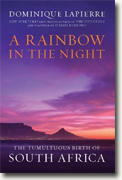A Rainbow in the Night
Dominique Lapierre
book reviews:
· general fiction
· chick lit/romance
· sci-fi/fantasy
· graphic novels
· nonfiction
· audio books
· author interviews
· children's books @
curledupkids.com
· DVD reviews @
curledupdvd.com
newsletter
win books
buy online
links
home
for authors
& publishers
for reviewers

 |
A Rainbow in the Night: The Tumultuous Birth of South Africa Dominique Lapierre Da Capo Press Hardcover 320 pages November 2009 |
|
Lest we forget, Dominique Lapierre, author of the bestselling The City of Joy, has shed light on the history of one of the world’s most naturally beautiful countries with a blood-soaked heritage spanning centuries, continents and races.
Once long ago, the tip of the African continent was an idyllic paradise of nature’s bounty populated by a few disparate tribes of pastoral and hunter-gathering peoples. It was “discovered” by Dutch traders in the 17th century, to be used for a supply base for ships rounding the Cape from Europe to the spice-rich shores of India. But the religious Dutchmen discovered something else: diamonds, and soon after gold, and the conquest and battle for dominance began. Fierce contenders were the self-styled “Afrikaners” or Boers of the Netherlands, who made a commitment to live forever in the region no matter what the cost; the organized and war-ready colonial British; and local tribes like the Xhosas and Zulus. These often warlike natives attempted to coexist with the encroaching bands of whites and, when that failed, to drive them out. But, lacking modern weaponry, they were forced to compromise and ultimately to surrender. Their identities were destroyed first by the grinding necessities of the cash economy and then by a form of government that utterly excluded them from the processes of government and civil life. By the mid-twentieth century, the regime of the Boers had achieved its ends - a society quantified, codified and obsessed by race. The poorest white was proud of his or her superiority to any black or “colored” person. This arrogance (accompanied by cruelties both minor and major) was underpinned at every level by the complex laws of apartheid: “It was a country where wild animals were collected in sumptuous reserves but millions of people were packed into degrading ghettos.” Where racial mixing had once been successful, such as in Capetown, the dream of equality died as blacks were forcibly removed to barren homelands. When nonviolent resistance was mounted, it was met with guns and the brutal power of the state. Reasoning as only the racially driven can do that the native Africans needed to “develop” separately, the apartheid government banished blacks - 75% of the population - to 13% of the land, and that land was desert. Given “self-government,” the people thus abandoned were no longer the responsibility of the white baaskap. They were being left to die. Were it not for great heroes such as Nelson Mandela and Desmond Tutu (the two most familiar to the world at large) and many others like them, the plan of the stubborn racially motivated Boers might have worked. To the credit of the British, they continued to work quietly behind the scenes in the post-colonial era to make incremental small changes in the country’s fate. It can be argued that apartheid collapsed under its own weight and the disapprobation of civilized nations. But it required many people fighting back little by little from within and without for years to finally topple the giant. Lapierre’s book is marred by a tinge of romanticism and an unscholarly tendency to dramatize rather than stick to the historical facts. The ANC is lionized, with much of the country’s recent history seen almost solely through the eyes of Mandela. The Zulus are depicted as a reckless outlaw tribe rather than the strong political force they remain, in opposition to the ANC and its aims. Those who love South Africa but fear for its future now that it has become bogged down with violent crime and a crumbling infrastructure will not feel comfortable with this essentially “rainbow tinged” portrait. But it does give us an evocative reminder of how skin color divides, lest we forget… Originally published on Curled Up With A Good Book at www.curledup.com. © Barbara Bamberger Scott, 2009 |
|
|
|
 Click here to learn more about this month's sponsor! |
|
| fiction · sf/f · comic books · nonfiction · audio newsletter · free book contest · buy books online review index · links · · authors & publishers reviewers |
|
| site by ELBO Computing Resources, Inc. | |
 To a new generation, South Africa is perhaps just another African nation, more peaceful than some, a pleasant destination for tourism, a lively mix of traditions. But to those in their senior years who had involvement with the struggle of common folk for equality and empowerment, the story of South Africa is blazoned in human memory.
To a new generation, South Africa is perhaps just another African nation, more peaceful than some, a pleasant destination for tourism, a lively mix of traditions. But to those in their senior years who had involvement with the struggle of common folk for equality and empowerment, the story of South Africa is blazoned in human memory.